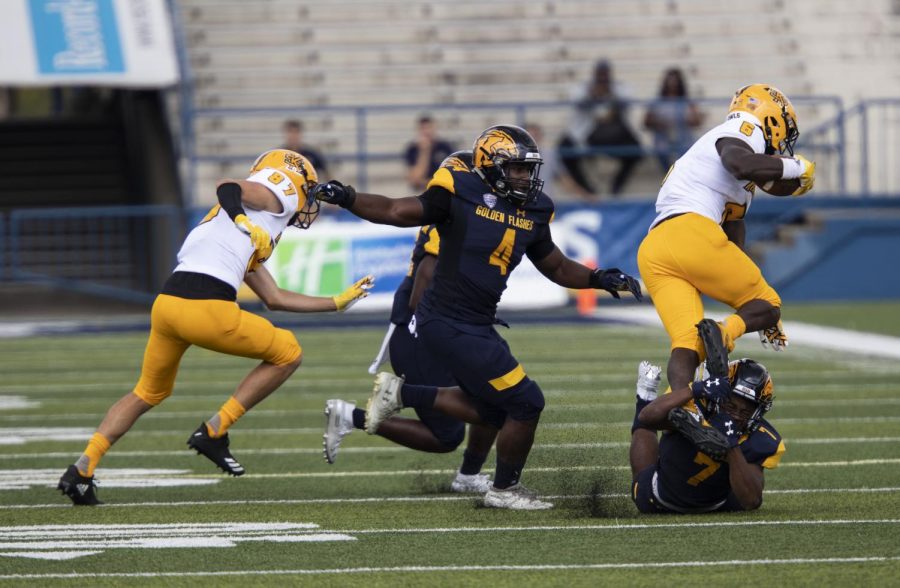Kent State’s run defense will play large role against Utah State
Senior cornerback Jamal Parker tackles running back TJ Reed during Kent State’s first home game against Kennesaw State University on Saturday, September 7, 2019. The Flashes beat Kennesaw State 26-23 in overtime.
December 20, 2019
Two things have been consistent with Kent State football during the 2019 season: junior quarterback Dustin Crum and the run defense.
Well, actually, the lack of run defense.
The Flashes rank 127th out of 130 FBS teams in stopping the run, allowing almost 250 yards per game. They have faced five top-25 rushing offenses, allowing 288.2 yards per game and 5.5 yards per carry. They were 1-4 against those teams.
It’s no secret to Kent State’s opponents that the Flashes struggled to stop the run. Three of the Flashes’ final four opponents ran the ball 50 or more times, but Kent State was 2-1 in such games. Utah State coach Gary Andersen chooses to take the Flashes’ rushing defense statistics with a level of skepticism.
“You can look at both defenses,” Andersen said. “At times, (Kent State) has played very well against the run and not so well against the run. I think there’s components that go into that. When you play the schedules that we play and the opponents that we play, these guys had Wisconsin, Auburn, Arizona State. Things can get really skewed. I think what you need to do when you talk about those things is break down our conference and see how we did.”
Taking into account only the eight conference games, Kent State allowed 219.2 yards per game and 18 touchdowns. They allowed two runs of at least 50 yards this season. They were 1-1 when allowing a run of 50-plus yards.
“Numbers can be skewed by the opponents we play,” Kent State senior linebacker Nick Faulkner said. “We played a triple-option team on top of three Power 5 opponents so the numbers are kind of skewed, but I will say there are some things you can always work on, but at the same time we’re no pushover in the run game.”
Utah State averaged 4.3 yards per carry using a high-tempo offense with limited substitutions to exhaust defenses. This approach netted them 16 rushing touchdowns and almost 150 yards per game.
The Aggies’ best rushing performance against an FBS opponent came against the University of Nevada. Utah State ran for 244 yards and two touchdowns in a 36-10 win.
The Aggies were 3-0 in games where they rushed for 200 or more yards this season. Kent State finished 3-5 when opponents rushed for over 200 yards this season.
“They have (quarterback Jordan) Love and a couple other good weapons,” Faulkner said. “At the end of the day, it comes down to us and what we can do for ourselves and making sure we’re doing things right. As long as we do that, we’ll be good.”
Utah State’s backfield consisted of two running backs who rushed for over 500 yards this season. Gerold Bright and Jaylen Warren combined for 13 touchdowns, while each averaged over five yards per carry.
“We just have to start fast,” Faulkner said. “They’re a good team, so we can’t really afford to get out to a slow start. We’re gonna make sure we’re on it from the jump. As long as we do what we’re capable of doing, I think we’ll be fine.”

























